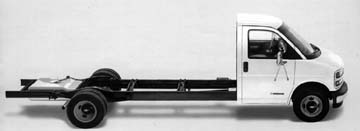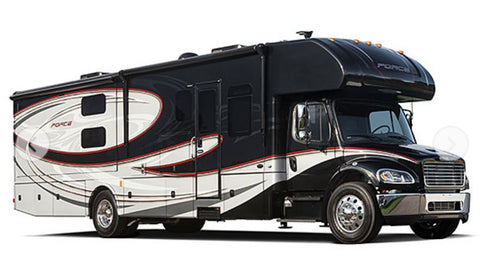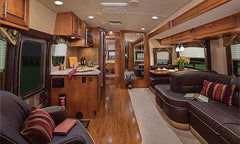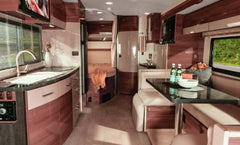RV Types
Class A Class B Class-C
Fifthwheel
Travel Trailer
Class C Motorhomes

The class C or mini motor home has been very popular since the early '70s. We at RVCG generally consider the class C a safer motor home than the class A for a number of reasons, but primarily for the cockpit construction, with the frontal crush area and all-steel cage offering protection for driver and passenger in a rollover situation — protection that is either minimal or completely lacking in a class A. With their greater fuel economy, ease of handling, and the snowbirding potential of some models, more RVers are becoming attracted to these "minis."
The class C is actually built on what is known as a cutaway chassis. This means the entire front of the vehicle — which includes the engine, doors, dash, and cockpit area — is of the same general construction and appearance as a van or a truck. Because the class C chassis has evolved from a standard road vehicle designed for family or commercial use, it has many of the built-in safety features normally associated with those types of vehicles. With cockpit design being one of the great weaknesses of class A motor homes, more RVers are considering the class C for its relative crashworthiness.

A Typical Cutaway Chassis
A big plus for the class C is that the front TV, if any, is usually mounted in an entertainment center in the cabover behind the cockpit, in contrast to class A's where a TV is often mounted over the driver's and passenger's heads in the cockpit. You'll rarely find a class C with an overhead TV in the cockpit. However, a few older models were constructed with this hazardous feature. If you find one of these, pass it up. The majority of class C's on the market today have TVs in safer locations. On the other hand, you will still need to make sure it's securely fastened into its housing. If an accident occurs when passengers are riding in the living area, a falling TV could inflict serious injury or worse.
Introduced in 1996, Ford's 14,050-pound GVWR cutaway chassis with V10 engine helped boost many class C's into the snowbirding classification. This chassis allowed mini motor home manufacturers to build their 28 to 30-foot motor homes without overburdening the chassis. Then, the competitive scramble among manufacturers to add even more length, slideouts, and options to their RVs again left many of them with almost no payload capacity. In the ensuing years, manufacturers have continued to increase GVWRs, but full-wall slideouts and other "improvements" will undoubtedly leave many cutaway class C's still unable to carry a reasonable payload.

The Class C+ or "Super C"


More RVers are considering class C motorhomes for its relative crashworthiness
and highway control when designed with good specifications. Higher quality class C motorhomes are not for the faint of pocket. Ranging anywhere from $85,000 to $500,000 and higher, you get what you pay for - but, you will end up with an RV worth its value. A class C motorhome offers a wide variety of floorplans to accommodate for extended vacations.
With the idea that bigger is better, manufacturers continue each year to introduce new brands built not on van chassis, but on Chevy, Ford, International, and even heavy-duty Freightliner truck chassis. Most are now diesel-powered. These we designate as class C+ motor homes, some of which rival large class A's in size, luxury, and price tag.
A wide range of chassis capacities allows manufacturers to add multiple slideouts without overloading, and to design a great variety of styles and floorplans. As a cautionary note, we do, however advise you to think twice about the purchase of a motor home with multiple slideouts because of the weakening of the walls' structural integrity when slideouts are added.
When buying a class C or C+, the most important features you need to look for are chassis capacity and wheelbase. With all the available choices of engine power and type, it is also important that you select the correct engine for your needs. If you are considering carrying more than one passenger, you'll want to seriously think about where they'll sit and how they'll be strapped into the seats. You'll need to consider cockpit construction, location of TV, and whether or not the RV has slideouts when evaluating its safety in case of collision or rollover.
We believe that more retired RVers would stay in RVing longer because they'd feel more confident about their ability to handle a small class C. Admittedly, it is difficult to visit someone in a large class A and then have to return to your class C with its limited space and storage. However, we now know that the disciplines to accept and adjust to our limitations is an absolute necessity if we want to go RVing, sailing, and fishing, and to fully enjoy the freedom of the RVing lifestyle.
To learn more about class C's and how to inspect them, please avail yourself of our publications "How to Select, Inspect, and Buy an RV" and the RV Ratings Guide.





